Go-To Telescopes Under Suburban Skies is the first book specifically
written for amateur astronomers who own, or who are about to purchase, a
computer-controlled 'go-to' telescope. Computer control and automatic
location of objects in the night sky is now a feature of even
inexpensive astronomical telescopes (under $200), no longer just of the
more expensive models. The advantage of the 'go-to' capability is
enormous - the telescope can be aimed at any object in the sky with
great speed and accuracy - and so is the popularity of these
instruments.
GO-TO Telescopes Under Suburban Skies provides literally hundreds more
targets beyond those offered by the built-in 'nightly tours' that
feature on the telescope's computer handset (a feature incorporated by
most manufacturers). Although most 'go-to' telescopes have enormous
databases of objects they can find - usually running into tens of
thousands - the tours (that's suggested objects to look at) are always
very limited. Once you've seen the planets and bright objects that the
computer suggests, you're on your own...
This new book answers the question, 'What shall I observe next?' in a
way that is unique to 'go-to' telescopes. Unlike all existing books on
deep sky observing, GO-TO Telescopes Under Suburban Skies doesn't waste
space on RA/Dec co-ordinates or Star Maps and Finder Charts for
suggested objects. It is designed expressly to be used alongside a
'go-to' telescope, using the NGC and SAO menus on the computer handset
to quickly slew the telescope to each new target. This is unique, and
makes the book much more information-rich than other observing guides.
Targets are arranged by season to maximise the chances of a given object
being visible at the time of observing, and then are divided into four
categories: three deep sky categories of increasing difficulty, and then
one category of stars that covers things like coloured stars, multiple
stars, and loose clusters/streams. The reader can quickly turn to the
relevant season, and then work through the list of objects.
All existing books about practical deep-sky observing are biased towards
non-'go-to' telescope owners and usually assume large-aperture
instruments and/or dark, rural or desert skies. This book makes the more
realistic assumption that the amateur astronomer has a relatively small
telescope and is observing from a backyard in a suburban area.
Instead of devoting page after page to maps and co-ordinates, GO-TO
Telescopes Under Suburban Skies leaves the computer to locate targets by
using NGC and SAO catalog numbers, and so has the space to suggest many
more fascinating deep-sky targets and provide detailed observing lists
and information about what's being viewed.

